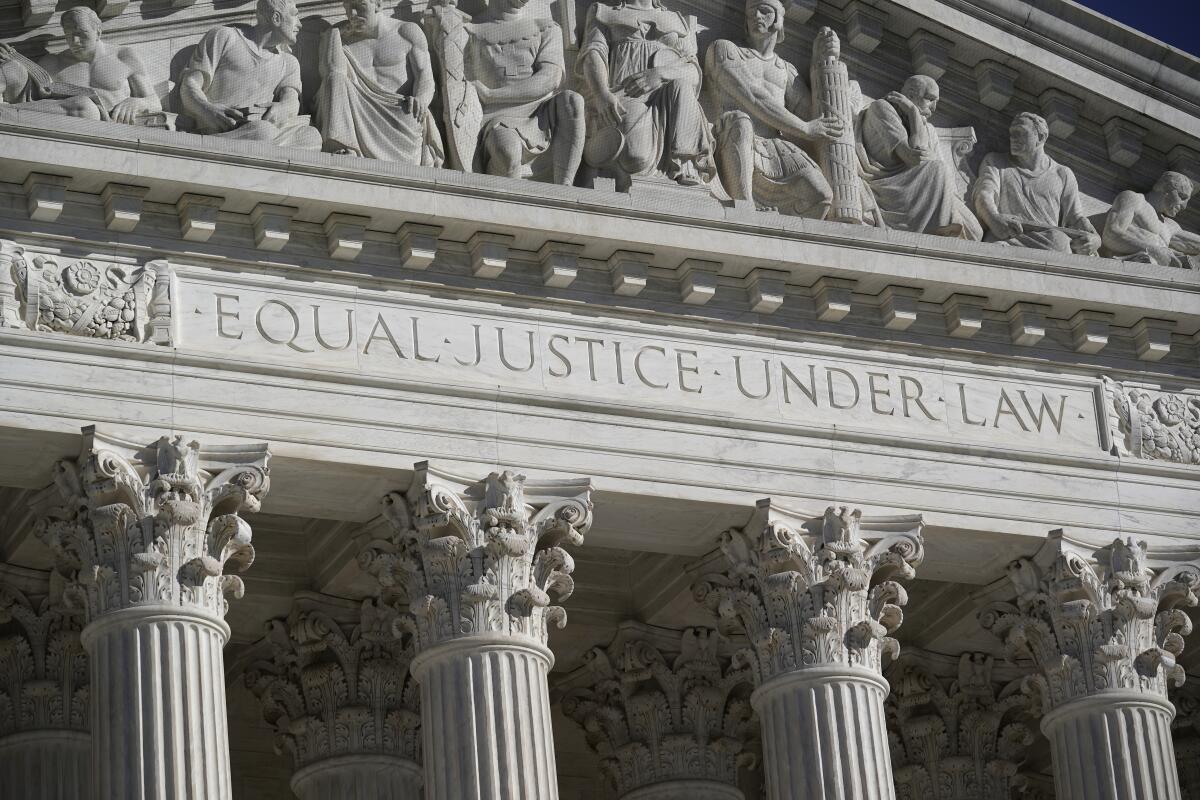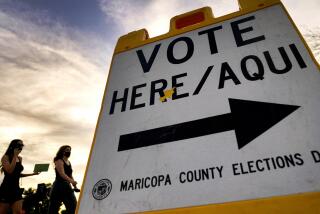Opinion: Why today’s Supreme Court decision on voting rights is such a shock

- Share via
After a decade of weakening federal protection of voting rights, the Supreme Court on Thursday reaffirmed that the Voting Rights Act prevents racial discrimination in drawing election districts. This was a surprising and important 5-4 victory for voting rights, with Chief Justice John G. Roberts Jr. writing the majority opinion, joined by Justice Brett M. Kavanaugh and the three liberal justices, Sonia Sotomayor, Elena Kagan and Ketanji Brown Jackson.
The decision in Allen vs. Milligan now requires Alabama to redraw its election map to create another district that likely would allow Black voters to elect a favored candidate.
The Voting Rights Act of 1965 is one of the most crucial civil rights statutes adopted in American history. Ever since Reconstruction, especially in Southern states, there has been pervasive discrimination to keep Black Americans from registering and voting. For example, in Mississippi, in 1962, less than 7% of the state’s eligible Black voters were registered to vote.
The Voting Rights Act had two key provisions to remedy race discrimination in voting. Section 5 provided that jurisdictions with a history of race discrimination in voting would need to get pre-clearance from the United States attorney general before making a change in their election systems. This was very effective in preventing discriminatory laws from going into effect.
But in June 2013, in Shelby County vs. Holder, the court declared unconstitutional the pre-clearance provisions of the law. Almost immediately, states such as North Carolina and Texas put into effect laws that had been denied pre-clearance because of their discriminatory effects. A crucial mechanism for stopping race discrimination in voting was nullified.
The other key provision of the Voting Rights Act, Section 2, prevents state and local governments from having election systems that discriminate against voters of color. In 1982, Congress amended this to make clear that the law prohibits laws that have a discriminatory effect against minority voters; there does not have to be proof that the government had a racially discriminatory purpose.
But two years ago, in Brnovich vs. Democratic National Committee, the court made it much harder to use Section 2 to challenge state and local election laws that regulate voting — such as rules on absentee ballots and the location of polling places. In an ideologically split decision, the court made it very difficult to prove a racially discriminatory effect and also said that there must be consideration of the state’s interest in preventing voter fraud, something never mentioned in the Voting Rights Act.
It is against this backdrop that Thursday’s decision in Allen vs. Milligan is most significant for what the court didn’t do: It did not further weaken the law of voting rights as many expected.
Alabama’s population is about 27% Black. Alabama has seven seats in the House of Representatives. After the 2020 census, the Alabama legislature in redistricting packed Black voters into one of the seven districts and spread them around the others, with the effect that Alabama was very likely to have only one Black representative in Congress.
The Supreme Court, following decades-old precedents, found that this violated the Voting Rights Act. In 1986, the court articulated a test for determining when election districting is racially discriminatory. Under that test, to prove a violation of the law, voters of color must demonstrate that they are large enough as a group to constitute the majority of a district, that they are politically cohesive, and that white voters in the proposed districting map would be likely to defeat candidates preferred by the voters of color.
Many analysts, including me, predicted that the court would use the Alabama case to weaken or overrule this test. This seemed likely because last year the court intervened in this case to allow the discriminatory map to be used in the 2022 primary and general elections in Alabama. After a three-judge federal court found it to be discriminatory and ordered a new map for congressional districts for the 2022 elections, the Supreme Court stepped in and issued a controversial order halting that ruling and granting review in the case.
But contrary to these predictions, Roberts’ majority opinion applied the 1986 test and found that Alabama violated the Voting Rights Act. Quite significantly, the court rejected Alabama’s contention that it was impermissible to consider race at all in evaluating whether election districts violate the law. If the court had accepted that argument, the implications for other civil rights laws would have been grave. That would have meant that discrimination in housing or employment could no longer be proved by showing racially discriminatory consequences.
Instead, the court said, “The contention that mapmakers must be entirely ‘blind’ to race has no footing in our §2 case law.” Justice Clarence Thomas, in dissent, made the radical claim that Section 2 of the Voting Rights Act does not apply to race discrimination in districting at all, a position that would allow governments to discriminate against minority voters with impunity in drawing election districts for Congress, state legislatures and local councils.
It’s a relief that the decision does not change the law or further eviscerate protection for voting rights. Indeed, given the Supreme Court’s recent history, its following precedent and finding a violation of the Voting Rights Act is practically a cause for celebration.
Erwin Chemerinsky is a contributing writer to Opinion and the dean of the UC Berkeley School of Law. His latest book is “Worse Than Nothing: The Dangerous Fallacy of Originalism.”
More to Read
A cure for the common opinion
Get thought-provoking perspectives with our weekly newsletter.
You may occasionally receive promotional content from the Los Angeles Times.










